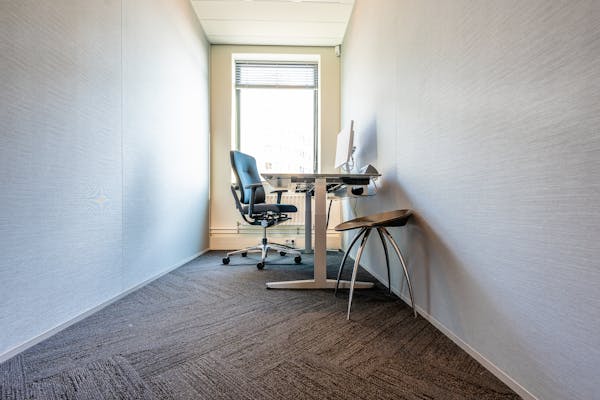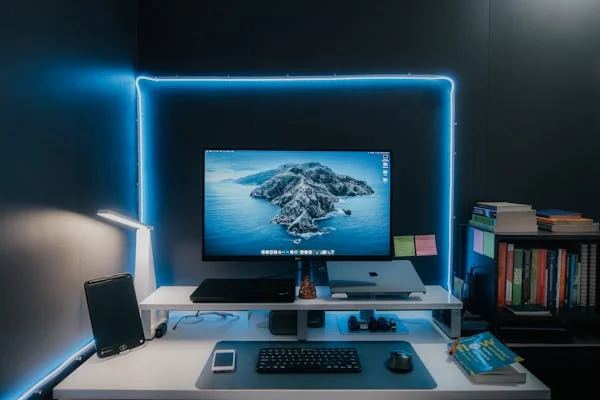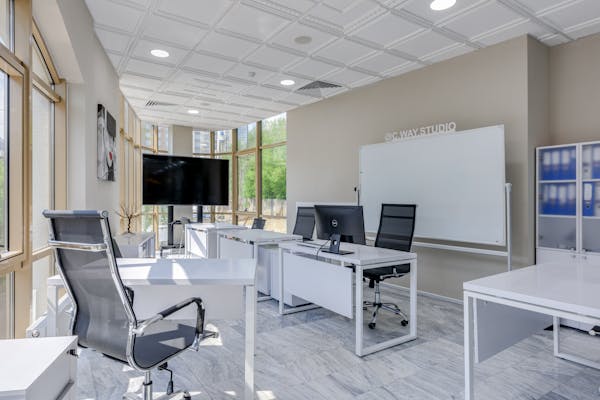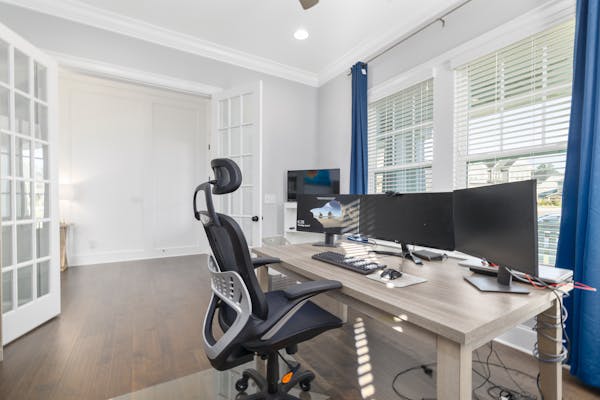
10 Steps to a Perfect Home Ergonomics Setup for Remote Workers
Remote work is here to stay, and with it comes the need to prioritize comfort and health in your workspace. Many remote workers overlook the importance of creating an ergonomic setup, but a well-designed Home Ergonomics Setup for Remote Workers can significantly enhance your productivity, well-being, and overall work experience. Whether you’re working in a dedicated office or a corner of your living room, an ergonomic workspace helps prevent physical strain and discomfort, which can otherwise lead to long-term health issues.
In this guide, we’ll dive deep into how to establish the perfect Home Ergonomics Setup for Remote Workers, offering practical tips for arranging furniture, choosing the right accessories, and optimizing your posture for maximum comfort. By implementing these steps, you’ll not only boost your physical health but also create a more efficient and focused workspace. Let’s explore the key elements that make a Home Ergonomics Setup for Remote Workers both comfortable and productive, allowing you to work at your best, day in and day out.
What is Ergonomics, and Why Does It Matter for Remote Workers?
Ergonomics is the science of designing workspaces, tools, and tasks to fit the needs of the user, reducing discomfort and minimizing injury risks. When applied properly, ergonomics helps create environments that promote physical health and well-being, making it especially crucial for remote workers. Without the right Home Ergonomics Setup for Remote Workers, individuals often experience discomfort such as back pain, neck strain, carpal tunnel syndrome, and fatigue, which can all impact productivity and overall job satisfaction.
For remote workers, the lack of an ergonomic setup is even more problematic because it often means spending long hours in non-optimal positions, without the benefits of an office environment that’s designed for comfort. Prioritizing ergonomics in your home office setup isn’t just about reducing pain—it’s about enhancing focus, improving posture, and boosting long-term productivity. By investing time and resources into a Home Ergonomics Setup for Remote Workers, you ensure that your workspace supports your body, reduces the risk of chronic conditions, and ultimately helps you feel more energized and engaged throughout the workday.
Common Problems of Poor Ergonomics in Home Offices
A poorly designed Home Ergonomics Setup for Remote Workers can cause both physical and psychological problems that negatively impact your overall well-being and productivity. When remote workers neglect proper ergonomics, they may experience a range of discomforts that make working from home more challenging. Let’s explore some of the most common issues associated with a lack of ergonomic awareness:
Physical Strain
- Back Pain: One of the most prevalent issues for remote workers is back pain, which is often caused by sitting in a chair without adequate support or sitting for extended periods without moving. In a Home Ergonomics Setup for Remote Workers, it’s essential to have a chair that provides proper lumbar support and encourages good posture. Without this, the muscles in your back can become strained, leading to chronic pain and discomfort, which significantly impacts your daily productivity and energy levels.
- Neck Stiffness: Poor monitor positioning in a Home Ergonomics Setup for Remote Workers is a common cause of neck stiffness. When the monitor is not positioned at eye level, workers often find themselves craning their necks or tilting their heads to view the screen, leading to muscle strain in the neck and shoulders. This issue can result in tension headaches and long-term damage if not corrected. Ensuring your monitor is at eye level and at an appropriate distance will help reduce neck strain and keep you comfortable throughout the day.
- Wrist Discomfort: Wrist pain is another significant issue faced by remote workers due to improper keyboard and mouse placement. When your Home Ergonomics Setup for Remote Workers doesn’t support a neutral wrist position, typing and using a mouse for long periods can lead to repetitive stress injuries like carpal tunnel syndrome. The height and angle of your keyboard and mouse are critical to reducing wrist strain. Using an ergonomic keyboard and mouse that fit your hand and wrist shape is vital for preventing discomfort and injury.
Psychological Impact
- Increased Stress and Fatigue: The physical strain caused by poor ergonomics in your Home Ergonomics Setup for Remote Workers doesn’t only affect your body but also your mind. Constant discomfort, whether it’s from back pain, neck stiffness, or wrist issues, can lead to heightened stress levels. As physical discomfort piles up, remote workers often experience fatigue, reduced motivation, and burnout, which can make it difficult to stay focused or engaged with work.
- Reduced Concentration and Motivation: Working in an ergonomically improper environment creates constant distractions in the form of aches and pains, which make it hard to concentrate on tasks. As your body fights discomfort, your brain has a harder time focusing, leading to reduced efficiency and productivity. Over time, these distractions can lead to lower job satisfaction and decreased motivation to perform well, further contributing to mental and physical exhaustion.
10 Essential Components for an Ergonomic Home Office

1. Invest in an Ergonomic Chair
When setting up your Home Ergonomics Setup for Remote Workers, your chair is the most important component to get right. A high-quality ergonomic chair provides the foundation for a comfortable and healthy workspace, helping to prevent physical strain and discomfort during long hours of work. Here’s what to look for:
- Adjustable Height and Lumbar Support: An ergonomic chair should allow you to adjust its height to ensure your feet are flat on the ground and your knees are at a 90-degree angle. Additionally, lumbar support is crucial to maintain the natural curve of your spine, reducing the risk of back pain.
- Padded Seat and Armrests for All-Day Comfort: A comfortable seat with adequate padding will support you throughout the day, reducing pressure on your hips and thighs. Armrests are also essential for relieving strain on your shoulders and wrists, especially when typing or using a mouse for extended periods.
Investing in an ergonomic chair will pay off in the long run by helping you maintain proper posture, avoid discomfort, and stay productive throughout the workday.
2. Get an Adjustable Desk
One of the most important elements in a Home Ergonomics Setup for Remote Workers is an adjustable desk. Having a desk that allows you to alternate between sitting and standing positions can significantly improve both your comfort and productivity. Here’s why an adjustable desk is a must-have:
- Elbows at a 90-Degree Angle: When seated, your desk should allow your elbows to rest at a 90-degree angle while typing or using your mouse. This promotes proper posture and reduces strain on your arms, shoulders, and wrists. An adjustable desk gives you the flexibility to set the perfect height for your work style.
- Flexible Working Position to Reduce Fatigue: Alternating between sitting and standing throughout the day helps prevent fatigue and reduces the risk of musculoskeletal problems. An adjustable desk allows you to easily switch between these positions, keeping your body engaged and energized. Standing for short periods can also improve circulation and reduce the negative effects of prolonged sitting, such as back and hip pain.
By incorporating an adjustable desk into your Home Ergonomics Setup for Remote Workers, you can maintain a more dynamic and comfortable work environment that supports both physical well-being and productivity.
3. Perfect Monitor Placement
Proper monitor placement is a key element in your Home Ergonomics Setup for Remote Workers. Incorrect monitor positioning can lead to neck strain, eye fatigue, and poor posture, all of which hinder productivity and comfort. To achieve the best setup, make sure your monitor is positioned correctly:
- Screen at Eye Level to Prevent Neck Strain: One of the most important ergonomic principles is keeping your monitor at eye level. This helps avoid the need to tilt your head up or down, which can strain your neck muscles over time. Positioning the top of the screen approximately 2 to 3 inches below your eye level ensures that you’re maintaining a neutral and relaxed neck position, even during long work hours.
- Distance of at Least 20 Inches from Your Eyes: For optimal viewing comfort, the distance between your eyes and the monitor should be at least 20 inches (about arm’s length). Sitting too close to the screen can lead to eye strain and fatigue, while sitting too far away can make it difficult to read text or see details clearly. Adjust the distance to suit your preferences, but ensure you’re not straining your eyes to read or focus on the screen.
By setting up your monitor correctly in your Home Ergonomics Setup for Remote Workers, you can reduce neck and eye strain, improve posture, and enhance your overall work experience.
4. Use an Ergonomic Keyboard and Mouse
An ergonomic keyboard and mouse are essential components of your Home Ergonomics Setup for Remote Workers, as they help reduce strain on your wrists, hands, and arms. Long hours of typing and using a mouse in awkward positions can lead to repetitive stress injuries like carpal tunnel syndrome. Here’s how to choose the right tools for comfort and health:
- Choose Split or Angled Keyboards to Reduce Wrist Strain: Traditional keyboards can force your wrists into unnatural positions, especially when typing for extended periods. Split or angled keyboards are designed to promote a more natural hand and wrist alignment, reducing the strain on your tendons and muscles. These keyboards allow your wrists to remain in a neutral position, minimizing the risk of discomfort and injury.
- Opt for a Mouse that Fits Comfortably in Your Hand: Just like your keyboard, your mouse should be ergonomically designed to reduce wrist strain. Choose a mouse that fits comfortably in your hand, with buttons placed in a way that doesn’t require you to stretch your fingers or grip too tightly. A properly designed mouse will allow you to maintain a more relaxed wrist position, preventing discomfort during long periods of use.
Incorporating an ergonomic keyboard and mouse into your Home Ergonomics Setup for Remote Workers is a simple but highly effective way to improve comfort, reduce strain, and boost your overall productivity.
5. Prioritize Good Lighting
Good lighting is a crucial aspect of your Home Ergonomics Setup for Remote Workers, as improper lighting can lead to eye strain, headaches, and fatigue. Whether you’re working during the day or late into the night, having the right lighting can significantly improve your comfort and focus. Here’s how to optimize your lighting:
- Use Natural Light to Reduce Eye Strain: Natural light is ideal for reducing eye strain and creating a more comfortable, productive environment. Whenever possible, position your desk near a window to take advantage of daylight. Natural light not only reduces the need for artificial lighting but also enhances mood and energy levels. Just be mindful of direct glare on your screen, which can strain your eyes. Use sheer curtains or blinds to diffuse sunlight and keep the lighting soft.
- Complement with an Adjustable Desk Lamp for Darker Hours: During the evening or in low-light environments, an adjustable desk lamp can provide the extra light needed without overwhelming your workspace. Opt for a lamp with adjustable brightness and a color temperature that reduces eye strain. A lamp with a flexible arm allows you to direct the light where you need it most, whether it’s focused on your desk or providing ambient light around your workspace.
By prioritizing good lighting in your Home Ergonomics Setup for Remote Workers, you’ll minimize eye strain, improve your focus, and create a more comfortable work environment, no matter the time of day.
6. Optimize Small Spaces
Not everyone has the luxury of a spacious home office, but with a bit of creativity, you can still create an ergonomic and functional Home Ergonomics Setup for Remote Workers, even in small spaces. Here’s how to make the most of limited room:
- Try Foldable Desks or Wall-Mounted Setups: If you’re working in a cramped area, foldable desks and wall-mounted setups are ideal for saving space. A foldable desk can be easily tucked away when not in use, allowing you to free up valuable room for other activities. Wall-mounted desks, on the other hand, can offer a compact, organized workspace while keeping the floor clear. Both options help you maintain a clutter-free, ergonomic workspace without sacrificing comfort.
- Use Multipurpose Furniture to Save Space: When space is at a premium, multipurpose furniture is a game-changer. Consider using furniture that can serve multiple functions, such as a desk with built-in storage or a chair that doubles as extra seating for guests. A storage ottoman can double as both a footrest and a place to store office supplies, while a fold-out desk can be used as a dining table when you’re not working. This way, you can maintain a clean, organized space while ensuring that all the essential ergonomic elements are still in place.
By optimizing your small space with these creative solutions, you can still achieve an ergonomic Home Ergonomics Setup for Remote Workers that supports your health and productivity, even in tight quarters.
7. Cable Management Solutions
Cluttered cables can not only create a chaotic work environment but also pose a tripping hazard. In your Home Ergonomics Setup for Remote Workers, effective cable management is key to maintaining a tidy, safe, and productive workspace. Here’s how to organize your cables:
- Use Velcro Straps or Cable Organizers to Tidy Up Wires: Velcro straps are an affordable and efficient solution to keep cables from tangling and cluttering your workspace. You can bundle cables together to reduce the mess, and Velcro allows for easy adjustment and reorganization. Alternatively, cable organizers are designed to keep wires neatly separated and out of sight, whether they’re under your desk or along the walls. These simple tools help reduce visual clutter, making your workspace feel more spacious and organized.
- Under-Desk Cable Management Trays: For a more permanent solution, consider installing cable management trays underneath your desk. These trays can store cables, power strips, and chargers out of sight while keeping them easily accessible. This not only keeps your desk surface clean but also prevents cables from getting tangled or damaged.
By implementing effective cable management in your Home Ergonomics Setup for Remote Workers, you’ll create a cleaner, safer workspace that supports both productivity and physical well-being. A tidy desk can lead to a clearer mind and a more efficient workday.
8. Add Comfort with Footrests and Cushions
In your Home Ergonomics Setup for Remote Workers, comfort isn’t just about your desk and chair. Small adjustments like footrests and cushions can make a significant difference in your overall comfort and posture. Here’s how to enhance your setup:
- Use a Footrest to Keep Your Legs at a 90-Degree Angle: Sitting for long hours without proper leg support can lead to discomfort and poor circulation. A footrest helps keep your feet flat on the floor and your legs at a 90-degree angle, which is essential for maintaining healthy posture. It also reduces pressure on your lower back and thighs, preventing fatigue and discomfort. An adjustable footrest allows you to customize the height and angle for optimal support.
- Cushions Provide Extra Lumbar Support When Needed: Even with a great chair, you may find that your lower back needs additional support. A lumbar cushion is designed to fill the natural curve of your spine, providing targeted support to your lower back. This simple addition can help alleviate back pain, especially during long work hours. There are also seat cushions available that add extra comfort to your chair, providing additional padding to relieve pressure points on your hips and thighs.
By adding footrests and cushions to your Home Ergonomics Setup for Remote Workers, you can create a more comfortable and supportive work environment that reduces strain on your body, improves your posture, and enhances your productivity.
9. Incorporate Movement
Sitting for long periods, even in an ergonomically optimized Home Ergonomics Setup for Remote Workers, can lead to stiffness, muscle tension, and eye strain. Incorporating movement throughout your day is essential for maintaining comfort and productivity. Here’s how to introduce movement into your work routine to enhance your home ergonomics setup for remote workers:
- Follow the 20-20-20 Rule to Rest Your Eyes Every 20 Minutes: Prolonged screen time can lead to digital eye strain, causing discomfort, dryness, and blurred vision. To combat this, follow the 20-20-20 rule: every 20 minutes, take a 20-second break to look at something 20 feet away. This simple strategy helps reduce eye strain and refreshes your focus, making it an easy yet effective way to preserve eye health as part of your Home Ergonomics Setup for Remote Workers.
- Include Stretching Breaks to Reduce Tension: Sitting in one position for long stretches can cause muscle tightness, especially in your neck, shoulders, and lower back. Combat this by incorporating regular stretching breaks into your workday. Simple stretches like neck rolls, shoulder shrugs, and lower back stretches help release built-up tension and improve circulation. These small movements are vital for maintaining the effectiveness of your Home Ergonomics Setup for Remote Workers, ensuring that you remain comfortable and free from the discomfort that often accompanies long hours at a desk.
By incorporating these movement strategies into your Home Ergonomics Setup for Remote Workers, you’ll reduce physical discomfort, boost circulation, and maintain energy throughout the workday. Taking these breaks will help keep you focused, comfortable, and productive in your home office setup.
10. Use Ergonomic Accessories
In your Home Ergonomics Setup for Remote Workers, incorporating ergonomic accessories can further enhance your comfort and productivity. These simple tools help improve posture, reduce strain, and support better overall ergonomics. Here’s how to optimize your workspace with these accessories:
- Laptop Risers: Elevate Your Laptop for Better Posture: If you’re using a laptop for extended periods, a laptop riser is a must-have accessory. By elevating your laptop screen to eye level, you can reduce neck and back strain caused by hunching over or looking down at your screen. This simple adjustment ensures that your head, neck, and spine remain aligned, promoting better posture and comfort throughout your workday. A laptop riser is a crucial component of a well-rounded Home Ergonomics Setup for Remote Workers.
- Anti-Fatigue Mats: Perfect for Standing Desks: If you use a standing desk, an anti-fatigue mat is essential for reducing the strain on your feet, legs, and lower back. Standing for long periods can put pressure on your joints and muscles, but an anti-fatigue mat provides cushioning and support, making it easier to stand for extended periods without discomfort. This accessory encourages healthier movement and posture, which is crucial in a Home Ergonomics Setup for Remote Workers who alternate between sitting and standing throughout the day.
By integrating ergonomic accessories like laptop risers and anti-fatigue mats into your Home Ergonomics Setup for Remote Workers, you create a workspace that promotes comfort, reduces discomfort, and enhances productivity. These small investments can make a significant difference in your overall work experience.
How to Maintain Your Ergonomic Workspace
Maintaining an ergonomic workspace is essential for long-term health and productivity. Over time, it’s easy to fall into bad habits, especially if your setup isn’t continually adjusted to suit your needs. Here’s how to keep your Home Ergonomics Setup for Remote Workers in top shape:
- Correct Sitting Posture: Your sitting posture is a key element in maintaining a healthy ergonomic setup. When seated, ensure that your feet are flat on the floor, with your knees at a 90-degree angle. This helps keep your legs and lower back in a comfortable position. Make sure your chair provides full lumbar support, supporting the natural curve of your spine to prevent back pain and fatigue. Sitting properly also reduces strain on your neck and shoulders, contributing to better overall comfort during long work hours.
- Regular Workspace Adjustments: As your work tools or tasks change throughout the day, it’s important to adjust your workspace to maintain ergonomic alignment. For example, if you’re transitioning from typing to a video call, adjust your chair height or monitor angle for better visibility and posture. Small tweaks, such as adjusting your chair’s lumbar support or repositioning your monitor, can make a huge difference in your comfort and reduce strain over time.

Do Ergonomics Work for Small Home Offices?
Absolutely! Even if your workspace is small, creating an ergonomic Home Ergonomics Setup for Remote Workers is completely feasible. With a little creativity and the right tools, you can make your compact space both functional and comfortable. Here’s how to optimize a small workspace:
- Use Vertical Storage Solutions: In a small office, maximizing vertical space is key. Wall-mounted shelves, pegboards, and vertical filing systems allow you to keep your desk clear while still providing ample storage for office supplies and documents. Keeping your workspace organized and uncluttered contributes to both your comfort and productivity in a smaller environment.
- Focus on Multifunctional Furniture: When space is limited, choose furniture that serves multiple purposes. Consider a foldable chair or compact desk that can be tucked away when not in use. A desk with built-in storage or a chair that doubles as extra seating can help you save space without sacrificing comfort or function. These versatile pieces are perfect for a Home Ergonomics Setup for Remote Workers where both ergonomics and space efficiency are priorities.
By following these strategies, you can create an ergonomic and efficient workspace, no matter the size of your home office.
Conclusion
Setting up an ergonomic home workspace might seem overwhelming at first, but the beauty of a Home Ergonomics Setup for Remote Workers lies in its simplicity and long-term benefits. Small, intentional changes—such as adjusting your chair, organizing your desk, and incorporating movement throughout your day—can significantly improve your comfort, productivity, and overall well-being.
Prioritizing your health with these essential steps not only reduces the risk of physical strain but also boosts mental focus and energy. Whether you’re working in a spacious home office or a cozy nook, the right ergonomic tools and practices can transform your workday, making it more enjoyable and sustainable. By investing in an ergonomic setup, you’re not just enhancing your workspace—you’re investing in your own health and happiness.
For more budget-friendly ergonomic solutions, check out Affordable Ergonomic Desk Setup for Remote Workers, where you can find practical advice on creating an ergonomic workspace without breaking the bank.
FAQ Section
1. What is the 20-20-20 Rule in ergonomics?
Every 20 minutes, look at something 20 feet away for 20 seconds to reduce eye strain.
2. How high should my desk be for ergonomic comfort?
Your desk should allow your elbows to rest at a 90-degree angle when typing.
3. Can I make a laptop ergonomic?
Yes! Use a laptop stand and an external keyboard and mouse for better posture.
4. What lighting is best for a home office?
Natural light is ideal, but adjustable desk lamps with warm white light are excellent alternatives.
5. Why is a footrest important?
A footrest ensures your legs stay at a comfortable angle, reducing back strain.
6. Can small home offices be ergonomic?
Yes, compact furniture and creative organization can make even small spaces ergonomic.
7. How do I prevent neck strain at work?
Position your monitor at eye level and avoid looking down for prolonged periods.
8. Are standing desks better than sitting desks?
Standing desks offer health benefits, but alternating between sitting and standing is best.

